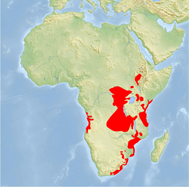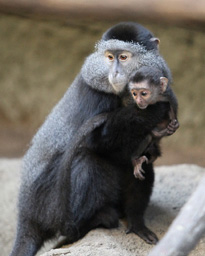Class: Mammalia
Order: Primates
Family: Cercopithecidae
Species: Cercopithecus mitis |
Distribution:
It is found in North Western Angola to South Western Ethiopia and down through southern Africa.
Habitat:
Blue Monkey is found in evergreen forests and montane bamboo forests, and lives largely in the forest canopy, coming to the ground infrequently. |  |
Description:
It is mainly olive or grey apart from the face (which is dark with a pale or yellowish patch on the forehead - the "diadem" from which the species derives its common name), the blackish cap, feet and front legs, and the mantle, which is brown, olive or grey depending on the subspecies. Typical sizes are from 50 to 65 cm in length (not including the tail, which is almost as long as the rest of the animal), with females weighing a little over 4 kg and males up to 8 kg. Lifespan:
They live up to 27 years in captivity. Diet:
It feeds on fruit, flowers, nectar, leaves, shoot, insects, birds and small mammals (including bush babies). Behavior:
Blue monkeys live in groups of about 20-40, often with only one adult male. The females will defend their territory against neighboring groups, with males only staying with the group between a few weeks and a couple of years at most. Adult males make loud calls that are specific to the individual.
 | Reproduction:
Breeding is seasonal, depending on the area. A single offspring is born after a gestation period of 5 months, fully furred and with its eyes open. The mother gives birth wherever she happens to be, and birth is usually at night. She eats the placenta and licks the baby clean as it clings to her belly. Other females in the group show great interest and try to hold new infants. Nursing becomes less frequent after the first few months, but continues until the next birth, usually after 2 years. Male offspring leave the group when they reach sexual maturity. Age of maturity is 3 years. |
Conservation status:
IUCN Red List: Least Concern.
References:
http://en.wikipedia.org/wiki/Cercopithecus_mitis
http://animaldiversity.ummz.umich.edu/site/accounts/information/Cercopithecus_mitis.html
http://www.iucnredlist.org/apps/redlist/details/4221/0
|